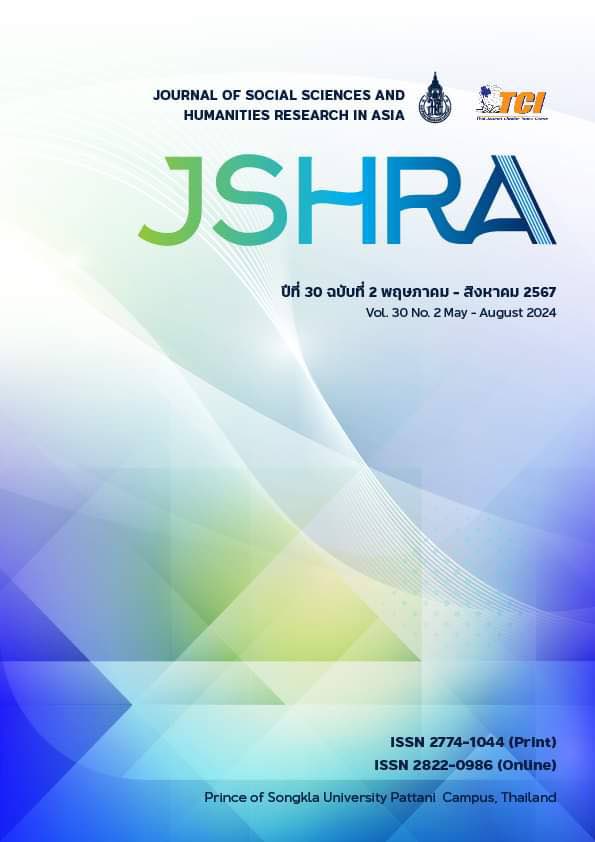Linguistic Landscape on Local Product’s Labels to Attract the Tourist : Mae Hong Son Province
Keywords:
Linguistic landscape, Language Strategies, Local Product’s Labels in Mae Hong Son provinceAbstract
This research studies the language landscape of local product labels in Mae Hong Son Province. The objectives were to 1) study language usage on local food and beverage product labels in Mae Hong Son Province, and 2) study the composition of images and colors that attract Thai and foreign customers. The purposive selection method was used to collect labels of local food and beverage products, a total of 90 labels from 25 shopping centers and souvenir shops. Then, the labels were distinguished, the remaining 50 for analyzing language usage and the composition of images and colors. The product labels were divided into two categories according to the criteria for registering OTOP products of Mae Hong Son Province: 1-2-star local product labels and 3-5-star local product labels. The tools consisted of label-recorded forms and language usage information forms evaluated and considered by three experts. The finding showed that 1-2-star and 3-5-star local product labels were monolingual (Thai or English language), bilingual (Thai and English languages), and multiple labels (Thai, English, and Chinese languages). The analysis of the composition of the images revealed that both label categories applied real photos and graphical images, which demonstrate the product identity. On the other hand, the color choices on 1-2-star local product labels employed harmonious, opposite, and monochromatic colors differently from 3-5-star local product labels that employed only harmonious colors.
References
Chatwirot, B., & Chatwirot, C. (2020). Development of product labels in English for OTOP products in Kamphaeng Phet Province For the new generation of farmers. Journal of Education, Faculty of Education, Kamphaeng Phet Rajabhat University. 5(9), 29-45.
Food and Drug Administration. (2018). Important components of food labels. Retrieved November 5, 2022, from https://oryor.com/media/infoGraphic/media_printing/1684?ref=search
Gorter, D. (2006). Introduction: The study of the linguistic landscape as a new approach to multilingualism. In Gorter, D. (Eds.), Linguistic landscape: A new approach to multilinguism (pp.1-6). England: Multilingual Matters.
Huebner, T. (2006). Bangkok’s linguistic landscapes: Environmental print, code mixing and language change. In Gorter, D. (Eds.), Linguistic landscape: A new approach tomultilinguism (pp.31-51). England: Multilingual Matters.
Jacobs, S.A., De Beer, H., & Larney, M. (2011). Adult consumers’’ understanding and use of information on food labels: A study among consumers living in the Potchefstroom and Klerksdorp regions, South Africa. Public Health Nutrition, 14, 510-522.
Kosittrakun, S. (2020). Information in English on local product labels: Perspectives from foreign tourists. Humanities & Social Sciences, 37(2), 204-227.
Kress, G., & Van Leeuwen, T. (2006). Reading images. London: Routledge.
Nichele, E. (2015). Non-Linguistic, Semiotic and global communication: 35 beer labeling cases. Language and Economics, 23(4), 1-11.
Mat, A.C. (2014). Translation of brand and food label products into Arabic: a Preliminary Linguistically Analysis. International Journal of Language and Literatures, 2(2), 121-135.
Mercer, R., Young, M., Rimpeekool, W., Marshall, A., Hector, D., Dickson, J., & Philips, R. (2013). Literature review on the impact of label format on consumers’ attention and comprehension for mandated label elements. Report prepared for Food Standards Australia New Zealand by instinct and reason, Canberra, Australia.
Rhekhalilit, K. (2020). Language choice of public signage in Thai universities a case study of Chulalongkorn University and Kasetsart University. Manutsayasat Wichakan, 27(2), 310-341.
Sankaphong, N., & Srihiran, J. (2017). Designing that identity on herbal drink labels according to the perception of Vietnamese people. [Conference session]. The 13th NationalAcademic Conference “Naresuan Research” (1929-1934). Phitsanulok: Naresuan University, Thailand.
Saysrikeaw, Y., Wannakayont, A., Dumnill, S., & Praisin, A. (2022). Product label design and apply qr code technology (QR Code) to communicate and increasing value of goods for processed products crispy shredded pork case study of producer Mae Tu Kawmeaw Samsi. Journal of MCU Makhondhat, 9(11), 145-160.
Singla, M. (2010). Usage and understanding of food and nutritional labels among Indian consumers. British Food Journal, 112, 83-92.
The Mae Hong Son Provincial Hall. (2018). Basic information: Important and famous products. Retrieved June 26, 2021, from http://www.maehongson.go.th/th/province-info/generalinfo/ product.html
Viroonphan, P., & Panyametheekul, S. (2019). Roadside restaurant signs in Yaowarat and Chatuchak: Semiotic landscapes analysis. Vacana Journal, 7(2), 1-25.
Yanhong, M., & Rungruang, A. (2013). Chiang Mai’s linguistic landscape in the tourist attraction areas: A study on the English language use on signs. The Golden Teak: Humanity and Social Science Journal (GTHJ.), 26(4), 59-70.











